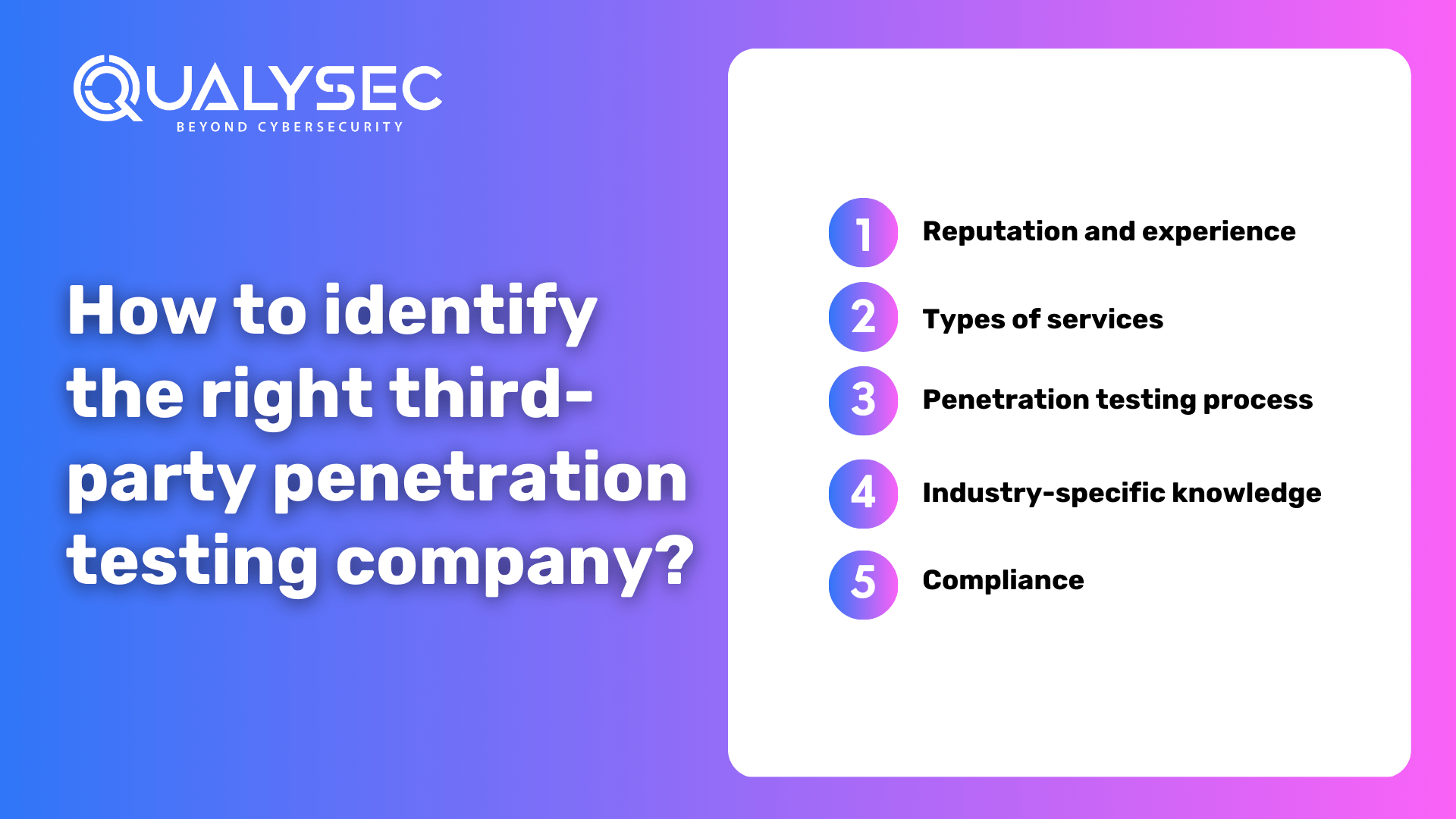In today’s digitized business world, every organization aims to prioritize its security system to safeguard confidential data from potential threats. While the organization may have used top security tools to prevent unwanted vulnerabilities. However, due to irregular updation of those security tools or insufficient knowledge about the latest cyber threats, vulnerabilities often go unnoticed until cybersecurity risks surround them. That’s why there is a need for an effective strategy to mitigate cybersecurity vulnerabilities. One such effective strategy includes third-party penetration testing.
In this comprehensive guide, you will read the significance of third-party penetration testing and a detailed roadmap for CISOs on authorizing a functional third-party pen testing program.
What is third-party penetration testing?
Third-party penetration testing, or external penetration testing, is a cybersecurity practice. In this practice, an external firm or individual accesses the security system of the company with the objective of identifying weaknesses and vulnerabilities to restrict attackers from causing potential threats.
Third-party penetration testers implement various techniques like vulnerability scanning, reconnaissance, exploitation, and reporting to penetrate the organization’s security system, including apps, websites, and clouds.
Unlike vulnerability assessment, expert pen testers perform third-party penetration testing services, and it is recommended that every organization should conduct penetration testing at least once a year to cope with the latest cybersecurity techniques.
Penetration testing or ethical hacking can be conducted both internally and externally. The companies reaching out to third-party firms or individuals fall under the category of external pen testing. In contrast, internal pen testing refers to understanding how real threats from the inside can exploit the system’s vulnerabilities.
Key differences between internal and external pentest:
*Internal Penetration Testing*
Internal pentest:
- Identify vulnerabilities through an inside perspective.
- Safeguard the system from potential threats who might have access to the system.
Examples of internal pentest:
- Wireless networks
- Intrusion Prevention Systems (IPS)
- Servers
Industry standards in Internal pentest:
- Internal Network Scan
- Password Strength Test
- Manual vulnerability testing and verification
*External Penetration Testing*
External pentest:
- Identify hidden vulnerabilities through its hacking techniques.
- Brings out a fresh perspective of an organization.
- Skilled ethical hackers perform Pentest to enhance and strengthen the security system.
Examples of external pentest:
- Authentication test
- Authorization test
- Error control test
- Intended business behavior test
- Input validating test
- Configuration and deployment management test
When should your organization connect with Third-party penetration testing?
Carrying out penetration testing is a complex process and requires skills, time, and in-depth knowledge. Generally, an organization’s security team doesn’t have access to the tools and methodologies required to conduct pen testing. A company should connect with the third-party penetration testing services provider whenever the following happens:
- A new application is created or updated.
- A potential unknown threat is discovered.
- Need of expertise to conduct penetration testing.
- A new data storage site is created.
- A continuous cyber attack is identified.
- Requirement of unbiased insights.
- The client need third-party penetration report.
- Multiple compliance requirements.
Benefits of third-party penetration testing
The following are the main benefits of having a third-party penetration test:
- Specialized skills: the most clear difference between internal and external pentest is the level of expertise and skill set. Thousands of the latest vulnerabilities were identified this year, making it difficult for internal pen testers to keep up with the latest techniques and tools. Third-party companies have extensive knowledge of the latest attacks, techniques, tools, and methodologies to discover vulnerabilities.
- Objective evaluation: the organization will get unbiased insights from third-party penetration testing service providers. Since the testers are unknown, there is less chance of vendor influence and manipulation, and it will only present the undiscovered vulnerabilities that the internal team might miss.
- Cost-effective: it’s a fact earlier detection and implementation of security vulnerabilities can save costs. This is also because the cost will be only for the services rendered, including reducing the risk of data breaches.
- Zero false positives: many third-party penetration testing service providers assure zero false positives regarding vulnerability identification and report in-depth insights into the process.
- Faster results: Third-party penetration testing providers will complete tests faster and smoother as compared to the internal pentest. Since external pentest experts are more familiar with the latest vulnerabilities and methodologies.
- Compliance: industries like health and finance have certain compliance to follow, for example, PCI-DSS, ISO 27001, HIPAA, and SOC Third-party penetration testing can support the industry by checking the regulation and presenting documented evidence of security for best practices.
- Commitment to testing and validation: third-party penetration testing is successfully raising the bar for the security industry and overall helps enhance customer trust and provides competitive advantages to the organization.
- Third-party assurance: penetration testing experts go the extra mile to provide an additional layer of assurance to application security, business partners, stakeholders, and customers.
Talk to our Cybersecurity Expert to discuss your specific needs and how we can help your business.
A CISO guide: Important steps before engaging a third-party penetration test.
Before directly consulting a third-party penetration testing service, it’s important to follow certain steps to ensure what exactly your organization wants from a penetration testing provider. CISO should do research and address key areas like:
- What types of cybersecurity tests are already performed?
- How often the company engages with penetration testing?
- How are vulnerabilities affecting the data and systems of the organization?
The following are the important steps a CISO can follow up when dealing with third-party penetration testing:
-
Cybersecurity scoping
The very first step is cybersecurity scoping. This step involves creating a clear understanding and agreement between the third-party pen testing and the organization. This step is crucial as it is performed to discuss the issues and decisions on what can or cannot be done. In conclusion, a set of rules are prepared before the tests.
This step is equally important for the pen testing team to get crucial information about the target organization. The team will also be able to present their services before starting the penetration testing.
-
Reconnaissance
This step includes the process of gathering data and information about the organization. The collected data might encompass a variety of data such as IP addresses, servers, footprinting, scanning, and domain details but under the target company’s permission.
The main objective behind this step is to get an overview of the assets (domain and sub-domains) and content. (specific resources of the assets)
With this informed data, testers can develop a specific strategy to examine the vulnerabilities in the later penetration testing process effectively.
-
Vulnerability Assessment
Once the target system is done with discussions and scanning, the next step is vulnerability assessment. This is a testing process where pen testers target to identify security defects and points of exploitation. It can be performed through both manual and automated techniques.
-
Exploitation
The earlier three consist of pre-attacks and assessments, but this step is about the actual attack. The objective of this step is not to destroy but to discover the roots of vulnerability and assess the potential threats.
Since this step involves practices like data breaches and unidentified data access to your organization’s sensitive data, it requires extra delicacy when handling and monitoring.
When a vulnerability is discovered, they exploit using various techniques and tools to gain internal access.
-
Reporting
The final step or process is reporting. Once all the earlier steps are performed and data exploited, a detailed report is created by the third-party penetration team. The report doesn’t only include the list of vulnerabilities but also shares the whole process, including decisions and agreements made prior to tests, threats found, assets and content identified in the exploitation process, and the relevant recommendations to address vulnerabilities.
Moreover, the methodologies and standards used during the exploitation will also be explained.
How to identify the right third-party penetration testing company?

-
Reputation and experience
Before finalizing the third-party pen testing company, it’s important to do a background check of the company because pen testing is a complex process and requires in-depth knowledge about the latest security techniques. CISOs can conduct research by contacting previous clients and reading reviews and case studies available on their websites.
To understand the third-party pen testing company more, you can organize a meeting to ask relevant questions related to their core team members’ methodologies, experience and expertise, certifications, and qualifications.
-
Types of services
Choosing the right third-pen testing provider depends on the company’s requirements. Many organizations hire penetration testing for security maintenance, while others aim for specific compliance like HIPPA, ISO 27001, GDPR, PCI-DSS and SOC.
If your organization is aware of the needs and requirements, it becomes smoother for pen testers to suggest specific services. Third-party penetration companies often customize tests according to the company’s objectives.
-
Penetration testing process
It is significant to learn about the process followed by the penetration testing company to understand what exactly the pen testers will perform during the penetration testing. Is the company you are going for follow industry standards and has compliance matching with your organization? Do the pen testing company perform retests? Does the company perform manual penetration testing after automated testing? And how they handover reports in post-authentication.
-
Industry-specific knowledge
Another crucial point to be noted by CISOs when choosing the right third-party pen testing team. Industry-specific knowledge here means having in-depth knowledge and awareness of the latest trends and updates about the cybersecurity industry.
Every organization wants to seek support from a team with skilled professionals and relevant qualifications and certifications.
-
Compliance
The organization must determine if third-party penetration testing is compliant with the company’s security goals. Choosing the right third-party pen testing team will help ensure the specific regulation and certifications after the tests.
Compliance is industry-specific, for example, PCI-DSS for financial sectors, HIPPA for health sectors, and more.
CISOs choice: Qualysec’s third-party penetration testing.
Qualysec is one of the leading cybersecurity service providers founded in 2020 that specializes in delivering comprehensive and reliable penetration testing services including third-party or external penetration testing. With experienced ethical hackers and security experts, Qualysec aims to collaborate with organizations to set a plan to run penetration testing to safeguard and boost the company’s discovered vulnerabilities and overall security posture.
Qualysec uses the much-needed combination of manual and automated pen testing during the process, along with some incredible services like:
- Penetration report
- Retest reports
- Letter of attestation
- Security Certificates
- References
In third-party/external penetration testing, Qualysec provides testing services like-
- Web App Pentesting
- Mobile App Pentesting
- API Pentesting
- Cloud Security Pentesting
- IoT Device Pentesting
- AI /ML Pen-testing
Hence, Qualysec’s comprehensive and reliable third-party penetration testing is suitable for your organization. Choose Qualysec to get in-depth insights and relevant recommendations from a skilled penetration testing team.
Latest Penetration Testing Report

Conclusion
Third-party penetration testing works as a trustworthy method for many organizations when internal testers fail or lack in-depth external knowledge. Hiring an external pen testing service provider can do wonders for a company’s security infrastructure. CISOs considering third-party penetration testing will discover unidentified vulnerabilities and gain compliance, reporting, certifications, zero false positives, methodologies conducted information, and relevant recommendations to safeguard and prioritize the company’s security.
Qualysec has successfully served thousands of clients to ensure their cybersecurity remains secure in this digital world. Their expertise, reputation, and reliable recommendations make them the top third-party penetration testing company. Hence, when looking for external/third-party pen testing, Qualysec is an organization to rely on.
FAQs
Q.1) What is third-party penetration testing?
Third-party or external penetration testing is a cybersecurity practice where a company hires an external penetration testing team or individual to access the security systems with advanced techniques to identify vulnerabilities that might go undiscovered by internal testers.
Q.2) What are the 5 steps of penetration testing?
The 5 steps of penetration testing are as follows: Cybersecurity scanning, Reconnaissance, vulnerability assessment, exploitation, and reporting.
Q.3) What are the methodologies used in third-party penetration testing?
Three main methods are used in third-party penetration testing during the vulnerability assessment process:
- Black box penetration testing
- Grey box penetration testing
- White box penetration testing
Q.4) Why penetration testing is carried out by a third party?
Penetration testing is carried out by a third party to find out unidentified vulnerabilities and weaknesses before they get exploited by cyber attackers.
Q.5) How often should a company do penetration testing?
In general, a company should be performing penetration testing on a regular basis: four times a year or whenever there is a core change made. However, the frequency of pen tests depends on the organization’s goals and requirements.
































































































































































































































































































































































































































































































































0 Comments